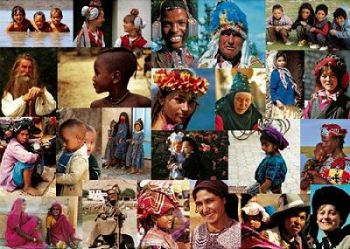Cultural diversity represents the set of different cultures that exist on the planet.
Culture comprises the set of customs and traditions of a people which are transmitted from generation to generation.
As cultural elements that are representative of a particular people, the following stand out: language, beliefs, behavior, values, customs, religion, folklore, dance, cuisine, art, among others.

What differentiates one culture from others are the constitutive elements, which consequently make up the concept of cultural identity.
This means that the individual belonging to a certain group identifies with the factors that determine their culture.
Cultural diversity encompasses the set of cultures that exist. These identity factors distinguish the set of symbolic elements present in cultures and it is they that reinforce the cultural differences that exist among human beings.
Many researchers claim that the globalization process interferes with cultural diversity. This is because there is an intense economic and cultural exchange between countries, which often seek homogeneity.
THE "UNESCO Universal Declaration on Cultural Diversity" was approved in 2001 by 185 Member States. It represents the first instrument aimed at preserving and promoting the cultural diversity of peoples and intercultural dialogue.
It should be noted that diversity is recognized as a “common heritage of humanity”.
understand more: cultural identity
Brazilian Cultural Diversity

Each Brazilian region has unique aspects related to customs, beliefs or cultural and artistic manifestations.
North region
Among the cultural manifestations present in the northern region of Brazil, the two largest popular festivals in the region stand out. They are: the Festival of Parintins and the Festa do Círio de Nazaré.
The Festival of Parintins is the biggest party in the boi-bumbá from the country. It was created in 1965 and takes place in the state of Amazonas.
The Círio de Nazaré Festival, in turn, is considered one of the largest Catholic religious manifestations in the country and takes place in Belém (PA).
Also in Belém do Pará, the stamp, a dance and musical genre of indigenous origins.
Some typical foods from the northern region are: cassava, tucupi, tacacá, jambu, dried shrimp, duck, alligator, pirarucu, buffalo mozzarella, sweet pepper and fruits (cupuaçu, bacuri, açaí, taperebá, soursop and buriti).
Read too: Northern Culture.
Northeast region
Among the cultural manifestations present in the northeast region of Brazil, there are many parties, dances, musical genres, namely: Bumba meu boi party, Iemanjá party, washing of the Bonfim stairs, Carnival, maracatu, caboclinhos, ciranda, coconut, zabumba suit, marujada, reisado, frevo, cavalcade.
Remember that the literature of twine it is a very present element in the northeastern culture as well as the handicraft made with lace.
Some typical foods of the northeast region are: acarajé, vatapá, caruru, dried meat, fish, seafood, sarapatel, buchada de bode, green beans, tapioca, corn bread, hominy, rice pudding, cooked cornmeal cake, cassava dough cake, pamonha, coconut candy, tapioca, foot of kid.
Read too: Northeast culture.
Midwest region
Among the cultural manifestations present in the central-west region of Brazil, the cavalhada, the fire, in the state of Goiás stand out. The folk dance of the cururu, which has indigenous origin, takes place in the states of Mato Grosso and Mato Grosso do Sul in the "Festa do Divino" and in the "Festa de São Benedito".
Some typical foods of the Midwest region are: chicken with pequi, Paraguayan soup, rice, Bolivian rice, gariroba, maria-isabel, Goiás pie, pamonha, angu, curau, fish (golden, pacu, painted, etc).
In this region there is a great mixture of cultural elements from indigenous, São Paulo, Minas Gerais, Rio Grande do Sul, Bolivian and Paraguayan cultures.
Examples of this diversity can be seen in the names of the many typical dishes of the region: "Bolivian rice", Paraguayan soup, "Goiano pie".
Read more about Midwest Culture.
Southeast region
Among the cultural manifestations present in the southeast region of Brazil, many religious and folkloric festivities stand out, in addition to the typical dances and musical genres of the region.
Among the elements present in the Southeast culture we can mention: feast of the divine, Easter and patron saints, cowboy parties, old people's dance, batuque, jongo, samba de handkerchief, festival of Yemanja, kings' revelry, kaiapo, congada, cavalhadas, Bumba my boi, Carnival.
Some typical foods of the Southeast region are: “Vado à São Paulo”, São Paulo couscous, feijoada, fried cassava, dumplings cod, Minas cheese, cheese bread, tropeiro beans, bean tutu, capixaba moqueca, pork, minced meat, farofa, pirão.
Learn more about Southeast culture.
South region
Among the cultural manifestations present in the southern region of Brazil, the festivals instituted by immigrants coming mainly from Europe in the 20th century stand out.
Among them, the biggest Brazilian German party stands out, with its first edition in 1984, called "Oktoberfest", the beer party.
Of German origin, this party takes place every year in the city of Blumenau-SC. Another very traditional party in the southern region of the country, of Italian origin and first held in 1931 is the "Festa da Uva" which takes place every two years in the city of Caxias do Sul-RS.
In addition, the fandango, of Portuguese origin, the tyrant and the anuo, of Spanish origin, stand out.
Other festivals and dances in the region are the feast of Nossa Senhora dos Navegantes, the congada, the boi-de-mamão, the ribbon dance, the boi na vara.
Some typical foods of the southern region are: wine, chimarrão, barbecue, shrimp, fish mush, roasted duck, barreado.
Learn more about South Region Culture.
Learn more about the topic:
- What is Culture?
- Brazilian culture
- Material and Immaterial Culture
- Popular festivals that are part of Brazilian folklore



